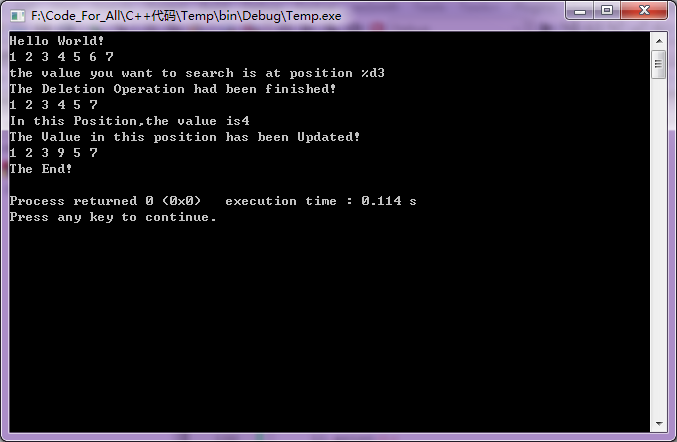жӮЁеҘҪпјҢзҷ»еҪ•еҗҺжүҚиғҪдёӢи®ўеҚ•е“ҰпјҒ
C++ й“ҫиЎЁ
д№ӢеүҚдёҖзӣҙжІЎжҖҺд№ҲеңЁж„ҸC++дёӯзҡ„й“ҫиЎЁпјҢдҪҶжҳҜзӘҒ然дёҖдёӢеӯҗи®©иҮӘе·ұеҶҷпјҢе°ұиҖҒжҳҜеҮәй”ҷгҖӮжІЎеҠһжі•пјҢеҶіе®ҡеҘҪеҘҪжҒ¶иЎҘдёҖдёӢиҜҘж–№йқўзҡ„зҹҘиҜҶпјҢд№ҹдёәд»ҠеҗҺзҡ„ж•°жҚ®з»“жһ„еӨ§дёӢдёӘиүҜеҘҪзҡ„еҹәзЎҖпјҢдәҺжҳҜжҲ‘жҖ»з»“еҮәд»ҘдёӢеҮ зӮ№пјҢжңүдәӣең°ж–№еҸҜиғҪдёҚжӯЈзЎ®пјҢиҝҳжңӣеӨ§е®¶дёҚеҗқиөҗж•ҷпјҢж—ЁеңЁе…ұеҗҢиҝӣжӯҘгҖӮ
жҖ»з»“пјҡ
1гҖҒй“ҫиЎЁListзҡ„еҹәжң¬еҚ•е…ғжҳҜиҠӮзӮ№NodeпјҢеӣ жӯӨжғіиҰҒж“ҚдҪңж–№дҫҝпјҢе°ұеҝ…йЎ»дёәжҜҸдёҖжӯҘжү“еҘҪеҹәзЎҖпјҢNodeзҡ„еҹәжң¬з»“жһ„еҰӮдёӢпјҡ
class Node{
public:
int data;
Node *next;
Node(int da=0,Node *p=NULL){
this->data=da;
this->next=p;
}
};
жҲ‘们еҸҜд»ҘзңӢеҮәпјҢNodeзҡ„жҲҗе‘ҳеҸҳйҮҸдёҖе…ұжңүдёӨдёӘпјҢйғҪжҳҜpublicпјҢеӣ дёәжҲ‘们иҰҒеҜ№иҝҷдёӨдёӘеҸҳйҮҸиҝӣиЎҢж“ҚдҪңпјҢжүҖд»ҘдёҚиғҪжҳҜprivateзұ»еһӢзҡ„гҖӮ然еҗҺжҳҜдёҖдёӘжһ„йҖ еҮҪж•°пјҢ第дәҢдёӘеҸӮж•°й»ҳи®ӨеҖјдёәNULLпјҢд№ҹе°ұжҳҜиҜҙеҰӮжһңжҲ‘们еҲӣе»әж–°иҠӮзӮ№ж—¶еҸӘжҢҮе®ҡ第дёҖдёӘеҸӮж•°пјҢиҖҢдёҚеҶҷ第дәҢдёӘеҸӮж•°пјҢйӮЈд№Ҳе®ғй»ҳи®Өзҡ„е°ұжҳҜNULLпјҢд»Ҙиҝҷз§Қж–№ејҸеҸҜд»ҘжӣҙзҒөжҙ»зҡ„дҪҝз”ЁNodeпјҢдёӘдәәе»әи®®иҝҷд№ҲдҪҝз”Ёе“ҰгҖӮ
2гҖҒ第дәҢжӯҘе°ұжҳҜеҲӣе»әжҲ‘们зҡ„й“ҫиЎЁдәҶпјҢеҗҢж ·жҲ‘们иҝҷйҮҢе…Ҳз»ҷеҮәй“ҫиЎЁзҡ„д»Јз ҒпјҢеңЁиҝӣиЎҢдёҖдёҖзҡ„и§ЈйҮҠгҖӮ
class List{
private:
Node *head,*tail;
int position;
public:
List(){head=tail=NULL;};
~List(){delete head;delete tail;};
void print();
void Insert(int da=0);
void Delete(int da=0);
void Search(int da=0);
};
жҲ‘们иҝҷйҮҢйқўжңүдёӨдёӘж•°жҚ®зұ»еһӢпјҢдёҖдёӘжҳҜNodeгҖӮеҸҰдёҖдёӘжҳҜжҢҮд»ЈиҠӮзӮ№дҪҚзҪ®зҡ„жҲҗе‘ҳеҸҳйҮҸпјҲиө·дёҚеҲ°д»Җд№ҲдҪңз”ЁпјҢдё”дёҚеҺ»з®Ўе®ғеҗ§пјүгҖӮдҪҝз”Ёheadе’ҢtailжқҘе‘ҪеҗҚдҫҝжҳҜдёәдәҶи§ҒеҗҚзҹҘж„ҸпјҢдҪҝж“ҚдҪңжӣҙеҠ еҮҶзЎ®гҖӮ然еҗҺжҳҜйҮҚиҰҒзҡ„е…ӯдёӘеҮҪж•°пјҢеҗ„иҮӘзҡ„еҠҹиғҪдёҚиЁҖиҖҢе–»е’ҜпјҢе…¶е®һжңҖйҮҚиҰҒзҡ„жҳҜеңЁжҜҸдёҖдёӘеҮҪж•°дёӯжҲ‘们йғҪй»ҳи®ӨиғҪж“ҚдҪңheadе’ҢtailдёӨдёӘжҲҗе‘ҳеҸҳйҮҸпјҢиҝҷж ·иғҪз®ҖеҢ–жҲ‘们зҡ„еҸӮж•°еҲ—иЎЁпјҢдҪҝеҫ—еҮҪж•°жӣҙеҠ дјҳйӣ…гҖӮ
дёӢйқўжҳҜжҲ‘зҡ„дёҖдёӘеҚ•й“ҫиЎЁзҡ„е®һзҺ°пјҢеҢ…еҗ«еҲӣе»әй“ҫиЎЁпјҢжҸ’е…ҘеҖјпјҢеҲ йҷӨзү№е®ҡзҡ„еҖјпјҢжҹҘжүҫзү№е®ҡеҖјеҫ—еңЁй“ҫиЎЁдёӯзҡ„дҪҚзҪ®гҖӮ
#include<iostream>
using namespace std;
class Node{
public:
int data;
Node *next;
Node(int da=0,Node *p=NULL){
this->data=da;
this->next=p;
}
};
class List{
private:
Node *head,*tail;
int position;
public:
List(){head=tail=NULL;};
~List(){delete head;delete tail;};
void print();
void Insert(int da=0);
void Delete(int da=0);
void Search(int da=0);
int getValueAt(int position);
void setValueAt(int position,int da);
};
int List::getValueAt(int position){
Node *p=head;
if(p==NULL){
cout<<"The List is Empty!"<<endl;
}else{
int posi=0;
while(p!=NULL&&posi!=position){
posi++;
p=p->next;
}
if(p==NULL){
cout<<"There is no value of this position in this List!"<<endl;
}else{
cout<<"In this Position,the value is"<<p->data<<endl;
}
}
return p->data;
}
void List::setValueAt(int position,int da){
Node *p=head;
if(p==NULL){
cout<<"The List is Empty!"<<endl;
}else{
int posi=0;
while(p!=NULL&&posi!=position){
posi++;
p=p->next;
}
if(p==NULL){
cout<<"There is No Position in this List!"<<endl;
}else{
p->data=da;
cout<<"The Value in this position has been Updated!"<<endl;
}
}
}
void List::Search(int da){
Node *p=head;
if(p==NULL){
cout<<"Sorry, The List is Empty!"<<endl;
return;
}
int count=0;
while(p!=NULL&&p->data!=da){
p=p->next;
count++;
}
cout<<"the value you want to search is at position %d"<<count<<endl;
}
void List::Delete(int da){
Node *p=head,*q=head;
if(p==NULL){
cout<<"Sorry, The List is Empty!"<<endl;
return;
}
while(p!=NULL&&p->data!=da){
q=p;
p=p->next;
}
q->next=p->next;
cout<<"The Deletion Operation had been finished!"<<endl;
}
void List::Insert(int da){
if(head==NULL){
head=tail=new Node(da);
head->next=NULL;
tail->next=NULL;
}else{
Node *p=new Node(da);
tail->next=p;
tail=p;
tail->next=NULL;
}
}
void List::print(){
Node *p=head;
while(p!=NULL){
cout<<p->data<<" \a";
p=p->next;
}
cout<<endl;
}
int main(){
cout<<"Hello World!"<<endl;
List l1;
l1.Insert(1);
l1.Insert(2);
l1.Insert(3);
l1.Insert(4);
l1.Insert(5);
l1.Insert(6);
l1.Insert(7);
l1.print();
l1.Search(4);
l1.Delete(6);
l1.print();
l1.getValueAt(3);
l1.setValueAt(3,9);
l1.print();
cout<<"The End!"<<endl;
return 0;
}
//еңЁжӯӨжҲ‘жғіи§ЈйҮҠзҡ„жҳҜпјҢд№ӢжүҖд»Ҙж•°еӯ—4еңЁй“ҫиЎЁдёӯзҡ„дҪҚзҪ®дёә3пјҢжҳҜеӣ дёәе…¶жҳҜд»Һйӣ¶ејҖе§Ӣи®Ўж•°зҡ„
дёӢйқўжҳҜд»Јз ҒиҝҗиЎҢеҗҺзҡ„з»“жһңпјҡ

еҘҪдәҶпјҢеҚ•й“ҫиЎЁзҡ„еҹәжң¬ж“ҚдҪңеӨ§иҮҙе°ұжҳҜиҝҷж ·дәҶпјҢеёҢжңӣжҲ‘们йғҪиғҪд»ҺдёӯжңүжүҖ收иҺ·гҖӮеҰӮжһңжӮЁеҸ‘зҺ°д»Јз Ғдёӯжңүд»Җд№Ҳй”ҷиҜҜпјҢиҝҳжңӣдёҚеҗқиөҗж•ҷпјҢи®©жҲ‘们е…ұеҗҢиҝӣжӯҘеҗ§гҖӮ
ж„ҹи°ўйҳ…иҜ»пјҢеёҢжңӣиғҪеё®еҠ©еҲ°еӨ§е®¶пјҢи°ўи°ўеӨ§е®¶еҜ№жң¬з«ҷзҡ„ж”ҜжҢҒпјҒ
е…ҚиҙЈеЈ°жҳҺпјҡжң¬з«ҷеҸ‘еёғзҡ„еҶ…е®№пјҲеӣҫзүҮгҖҒи§Ҷйў‘е’Ңж–Үеӯ—пјүд»ҘеҺҹеҲӣгҖҒиҪ¬иҪҪе’ҢеҲҶдә«дёәдё»пјҢж–Үз« и§ӮзӮ№дёҚд»ЈиЎЁжң¬зҪ‘з«ҷз«ӢеңәпјҢеҰӮжһңж¶үеҸҠдҫөжқғиҜ·иҒ”зі»з«ҷй•ҝйӮ®з®ұпјҡis@yisu.comиҝӣиЎҢдёҫжҠҘпјҢ并жҸҗдҫӣзӣёе…іиҜҒжҚ®пјҢдёҖз»ҸжҹҘе®һпјҢе°Ҷз«ӢеҲ»еҲ йҷӨж¶үе«ҢдҫөжқғеҶ…е®№гҖӮ
жӮЁеҘҪпјҢзҷ»еҪ•еҗҺжүҚиғҪдёӢи®ўеҚ•е“ҰпјҒ